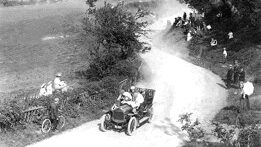July 2015 will mark the 110th anniversary of the first competitive motor-sport event in Wales, and it wasn’t at Pendine, which hosted the World Land Speed Record attempts in later years.
It took place in Barry on wednesday 8 July 1905 when a closed speed hill climb was held on Buttrills Hill and in the era when cars were still a rarity it was run over a 500yards course and won by G S Seccombe in a 12hp Wolseley with a time of 1m 22.4s.
The event was repeated in 1907 when Henry Webb climbed it in his Italia 40hp car, W Graham took his Daimler 35hp to the top quickest in 1908 and 1910 was the final running in June of that year when G A Phillips steered his Humber 2-seater to fastest time of the day.
In 1907 the Mountain road at Caerphilly was the venue for the first open hillclimb in Wales. Organised by the Cardiff Motor Club, the course was 1194 yards long and had an average gradient of 1 in 8.6 (right). Fastest time of the day was made by Sidney Smith in a 60 hp Napier. Another solo event was held on 14 October 1911. In 1912 the South Wales Auto Club and the Cardiff Motor Club joined together to promote a Welsh weekend, a hillclimb at Caerphilly, and a speed trial at Rest Bay, Porthcawl. These Welsh “doubles” were to become, along with the Shelsley Walsh and Saltburn events, the most important on the racing calendar, attracting the top drivers of the period.

A closed event that ran over a 1000 yard course in 1907, was won by Capt. D. Hughes-Morgan in a 28hp Daimler at Llangenech, Gower.
There were two further meetings over the Caerphilly course in 1912, with G H Woods Crossley 20hp and Miss Laura Starkey turning a wheel for women in the sport in her Sunbeam 12/ 16hp car.
A J Hancock won the Caerphilly Open meeting in a Vauxhall in June 1913 in 1m 04.6s.
Shortly before the outbreak of WW1 in August 1914, Caerphilly packed two meetings into the calendar that June and Leslie Hands Talbot 25/50hp and G D Pearce-Jones in another Vauxhall 25 were credited with Open and Closed event wins.
Following the end of hostilities in May 1920 the slopes below Caerphilly mountain were again resounding to racing engines, but this time in the opposite direction as Rhiwbina hill under Castel Coch was used by Cardiff MC to bring motor sport back into life and H G Evans set FTD in his Alvis 10/30. There is also a reference to a hill climb, but sadly no details, at Catsash, Newport in the 1920s.
Caerphilly restarted in 1922 with Open and Closed meetings on 28 June won by the Strake-Squire 4 litre of Bertie Kensington-Moir and A E Keen in a Morris Cowley Sports.

The 1923 meeting saw the famous Malcolm Campbell in action in his mighty Sunbeam 4.9 litre 6cyl car vanquish all before them in the Open category the year before he set a new World Land Speed Record at Pendine of 146.16mph and the car is now at the National Motor Museum in Beaulieu. In the same meeting, Miss D Vaughan swept to the top in the Closed meeting in her Humber 8/18.
Only an Open Hillclimb meeting was held over the Caerphilly course in 1924 when Kensington-Moir again triumphed in his Strake-Squire in 1m01.4s.. Llinegar Hill outside Mostyn was used on Easter Monday 1923 and then the following year.
The Caerphilly climb continued as a stage on the Welsh rally for a few years and there are library images of crowds lining the course much in the same way as spectators turned out for this year’s Tour de France in Yorkshire.
Incidentally the first climb of a 440yards course was completed at Trengwainton, Penzance in July 1938 and won by J Jones who set FTD in his MG, but the precise model is not recorded but he was credited with 46.6s.
The next meeting in August 1939 was won by Phil Uglow in a HRG in a time of 42s. He had the distinction of winning again in the first post war climb at the course in September 1946 in his HRG. Tregrehan, St Austell has been tested by racers as well over a 600 yard climb.
In that year there was an event at Naish House, Portishead over 750yards and George Hartwell Alta 2.0 and Len Parker in an Allard 4400 V12 took Open and Closed honours. An Allard driven by K Burgess swept to the top at Naish House in May 1947, and it was a loose surface course adjacent to Gordano Services with some pieces later metalled before the M5 construction cut it in two.
Leslie Onslow Bartlett piloted his Mercury Special to victory in 28s at the Trengwainton meeting of that August. Ashley Cleave is recorded as winning the event in 1948 in a Morris 8/ 10 Special in 30.2s.
The first recorded climb at Lydstep Haven, Tenby in July 1949 ended with Ken Delingpole winning in his HRG in 38s and the following month the Trengwainton event saw a dead heat in 28.2s between Ashley Cleave in his Morris and W F Westcott in a Frazer Nash. The 880yards climb at Lydstep Haven was used again that September and Jack Moor used his special Wasp 500 to beat all-comers.
Between 1972 and 1974, Swansea MC ran five hillclimbs on the privately owned Penrice Estate, Gower. The tight 840yards course saw an absolute record of 29.13s set by Richard Thwaites. From 1995 to the present day, the club has also run the Llys y Fran hillclimb below the reservoir 10 miles north west of Haverfordwest. In South East Wales, Pontypool Park hosted events for five years in the mid-1970s. In Mid-Wales, a 1,650 yards hill at Epynt was opened in June 2007 and rose 130m.
Bristol MC held British championship climbs in the mid-1960s at Dyrham Park, on the A46 between Bath and the J18 M4 but stopped after a serious accident on the 800yards course. Longleat Park was revived as a venue for hill climbs in 1991 after starting 30 years earlier and utilised the slope which visitors now travel down from the main entrance. Porlock Toll road has also been used over the years in north Somerset.
For some further infomation look up:
Robin is the longest serving chairman of The Western Group. He's been vice chairman or chairman for over ten years and oversees the annual Western Group PR Driving Day each summer assisted by the group committee and supported by group members.
He contributes to a number of outlets in Wales and the UK, including the Driving Force editorial syndication agency feeding the biggest regional news and feature publishers in Britain.
Robin specialises in the Welsh automotive sector and motor related businesses with interests in Wales and publishes WheelsWithinWales.uk which covers news, features, trade and motor sport in Wales.

